Abstract
1. Effects of a naturally occurring flavonoid, silybin, on histamine release from human basophils were examined, in order to assess the potential utility in the treatment of allergic disorders. 2. The f-met peptide and anti-IgE-induced histamine release was significantly (P less than 0.05) inhibited in a concentration-dependent fashion. Conversely, no significant (P greater than 0.05) effect on calcium ionophore A23187-induced histamine secretion was documented. The inhibitory activity was significantly (P less than 0.05) reversed by elevating extracellular calcium concentrations. 3. The anti-allergic properties of silybin can be reasonably ascribed to a membrane-stabilizing activity, possibly related to an interference in calcium influx. These results indicate that an in vivo evaluation of the anti-allergic activity of silybin would be worthwhile.
Full text
PDF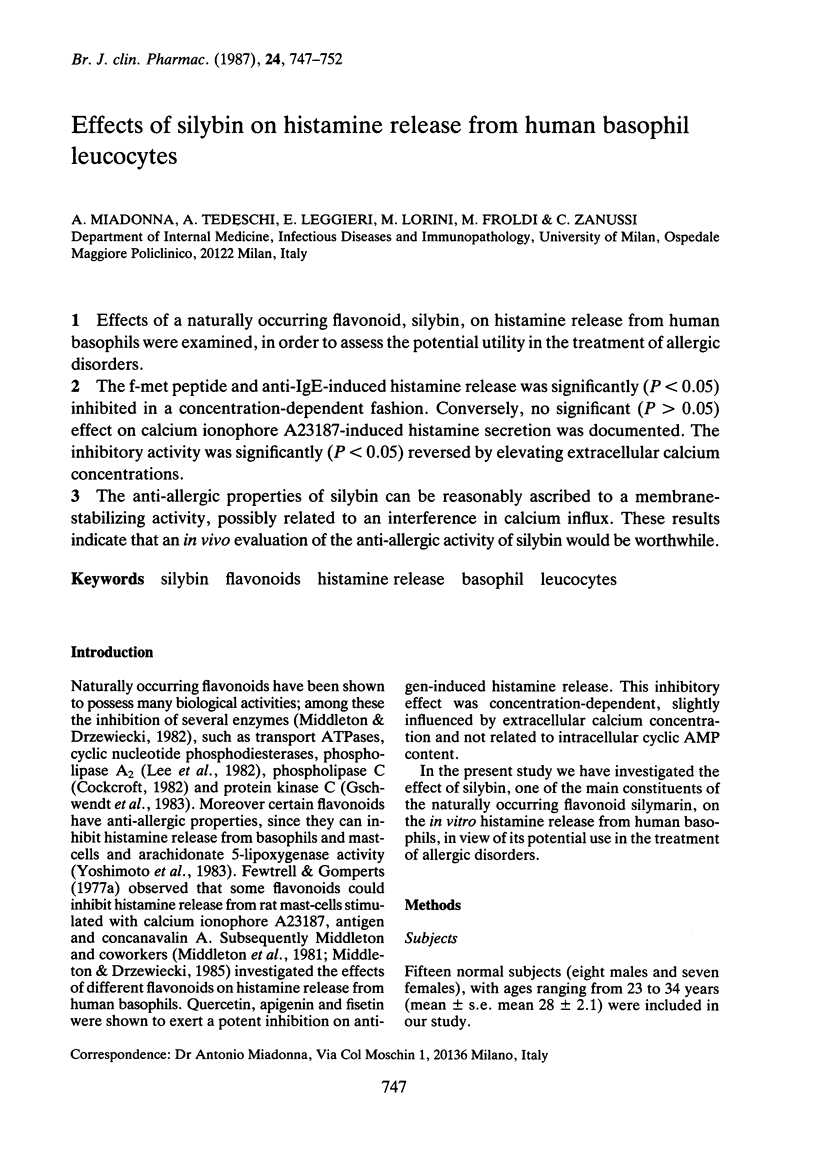
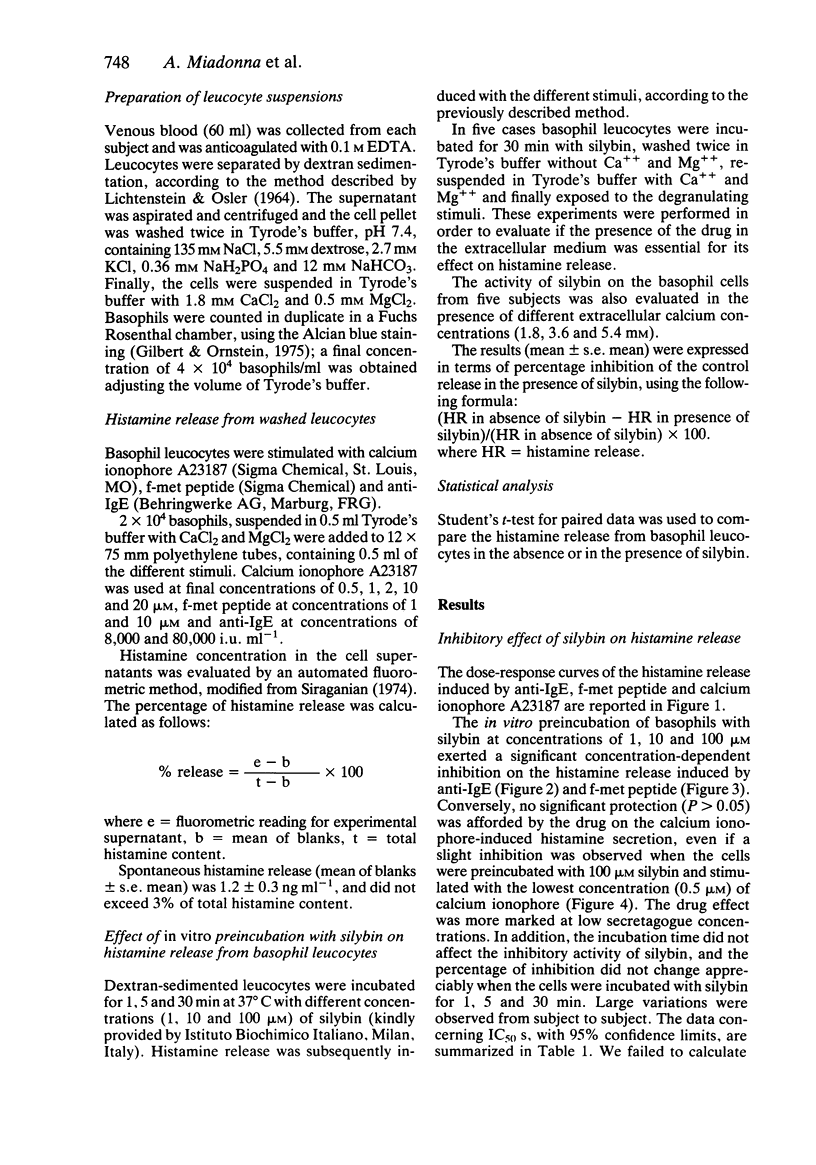
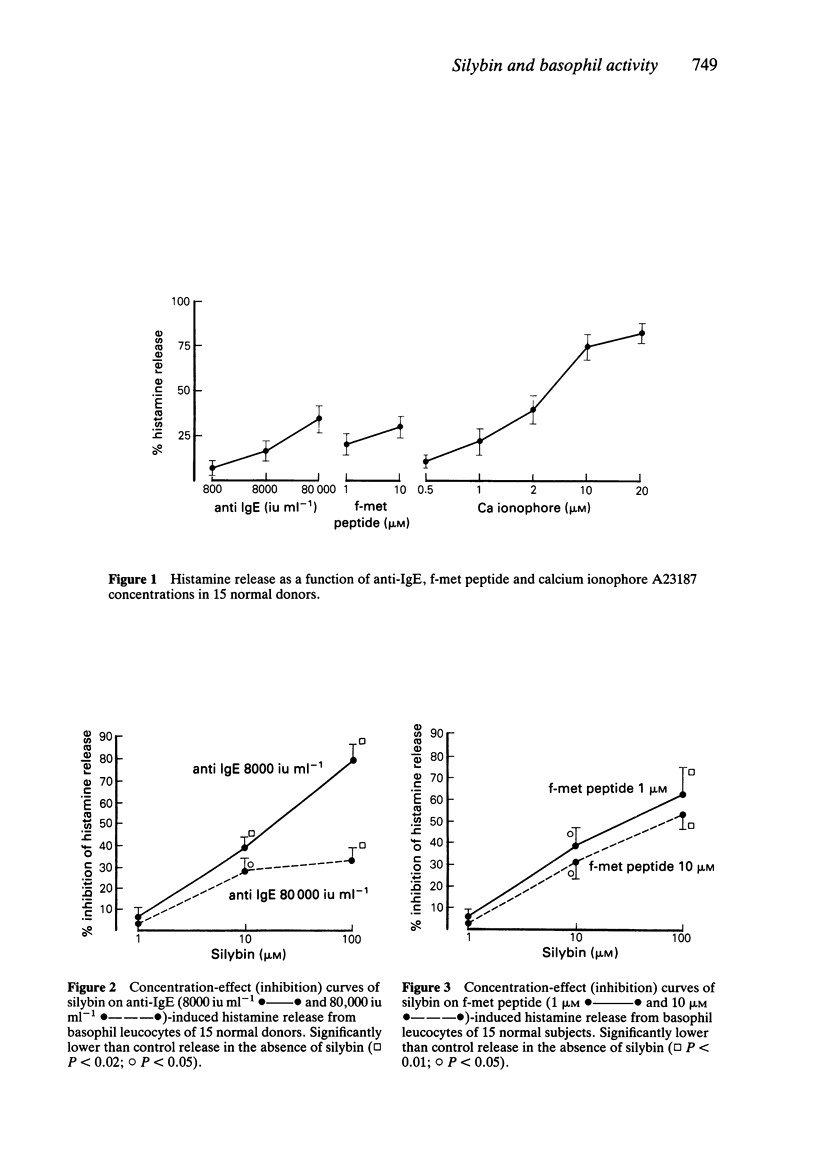
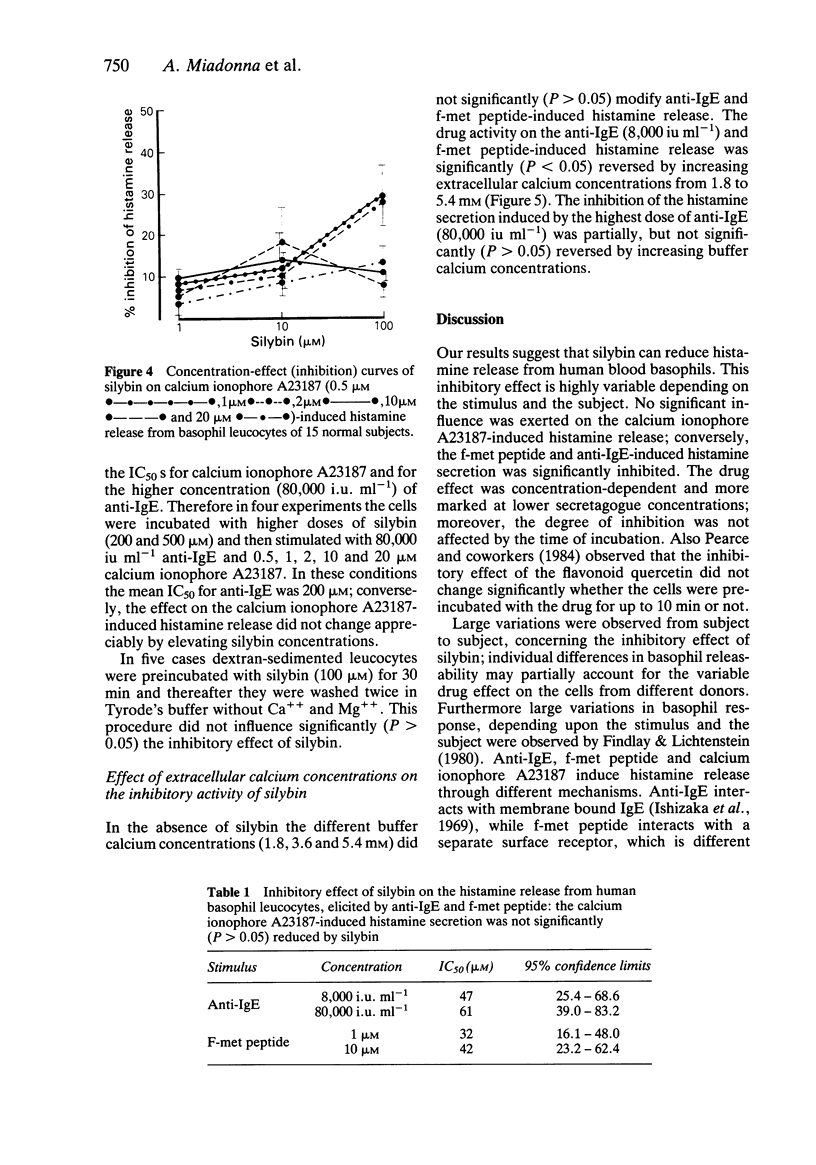
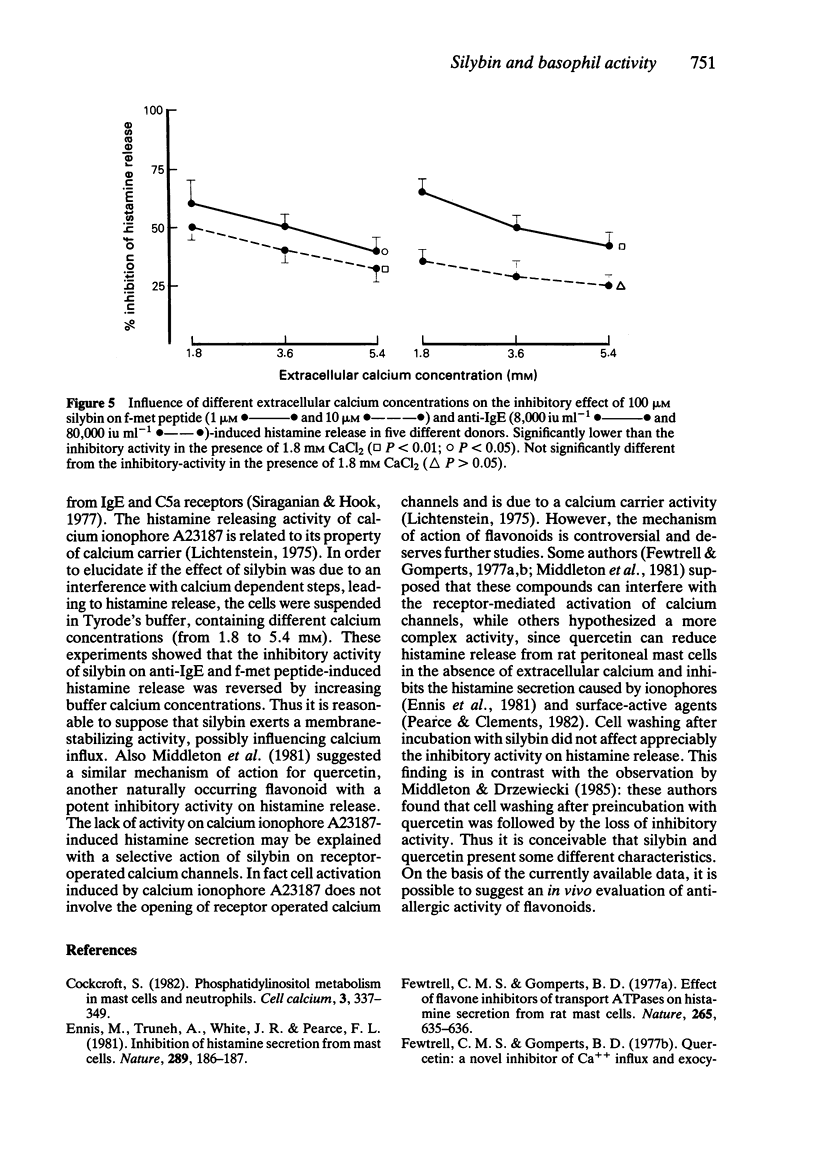
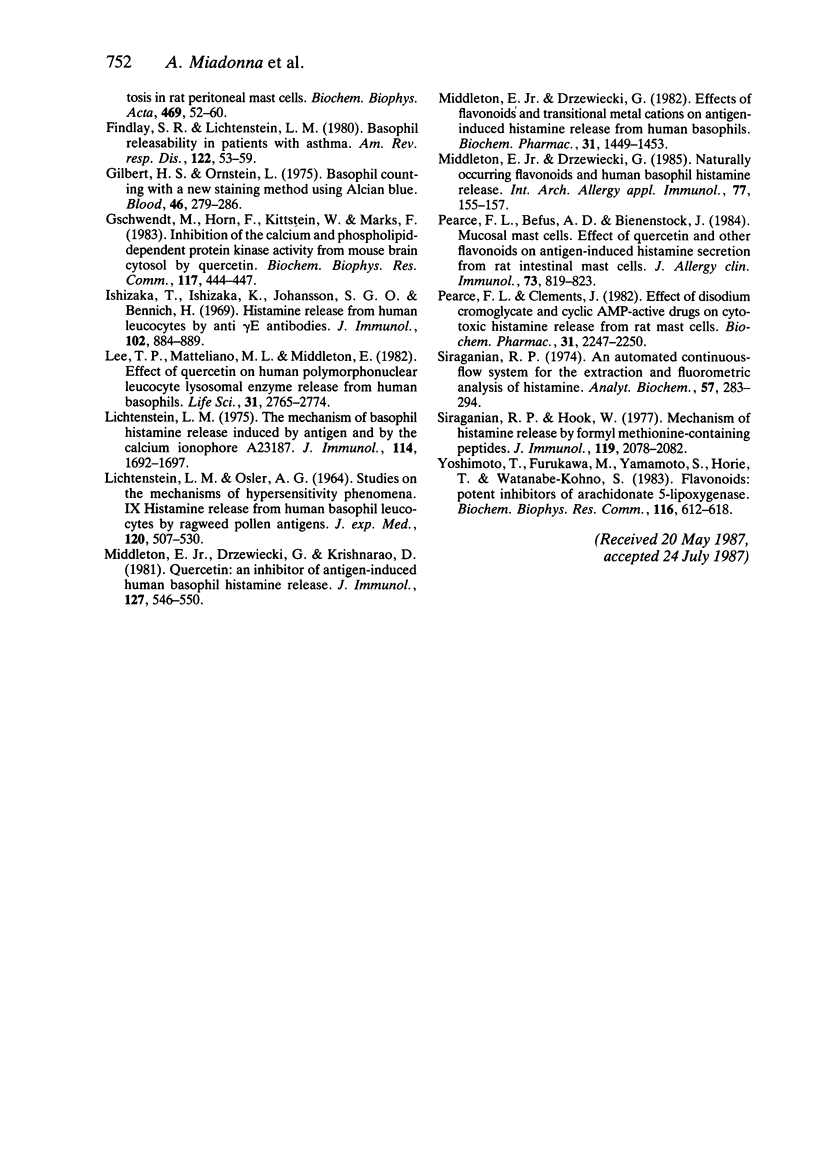
Selected References
These references are in PubMed. This may not be the complete list of references from this article.
- Cockcroft S. Phosphatidylinositol metabolism in mast cells and neutrophils. Cell Calcium. 1982 Oct;3(4-5):337–349. doi: 10.1016/0143-4160(82)90021-5. [DOI] [PubMed] [Google Scholar]
- Ennis M., Truneh A., White J. R., Pearce F. L. Inhibition of histamine secretion from mast cells. Nature. 1981 Jan 15;289(5794):186–187. doi: 10.1038/289186a0. [DOI] [PubMed] [Google Scholar]
- Fewtrell C. M., Gomperts B. D. Effect of flavone inhibitors of transport ATPases on histamine secretion from rat mast cells. Nature. 1977 Feb 17;265(5595):635–636. doi: 10.1038/265635a0. [DOI] [PubMed] [Google Scholar]
- Fewtrell C. M., Gomperts B. D. Quercetin: a novel inhibitor of Ca2+ influx and exocytosis in rat peritoneal mast cells. Biochim Biophys Acta. 1977 Aug 15;469(1):52–60. doi: 10.1016/0005-2736(77)90325-x. [DOI] [PubMed] [Google Scholar]
- Findlay S. R., Lichtenstein L. M. Basophil "releasability" in patients with asthma. Am Rev Respir Dis. 1980 Jul;122(1):53–59. doi: 10.1164/arrd.1980.122.1.53. [DOI] [PubMed] [Google Scholar]
- Gilbert H. S., Ornstein L. Basophil counting with a new staining method using alcian blue. Blood. 1975 Aug;46(2):279–286. [PubMed] [Google Scholar]
- Gschwendt M., Horn F., Kittstein W., Marks F. Inhibition of the calcium- and phospholipid-dependent protein kinase activity from mouse brain cytosol by quercetin. Biochem Biophys Res Commun. 1983 Dec 16;117(2):444–447. doi: 10.1016/0006-291x(83)91220-2. [DOI] [PubMed] [Google Scholar]
- Ishizaka T., Ishizaka K., Johansson S. G., Bennich H. Histamine release from human leukocytes by anti-gamma E antibodies. J Immunol. 1969 Apr;102(4):884–892. [PubMed] [Google Scholar]
- LICHTENSTEIN L. M., OSLER A. G. STUDIES ON THE MECHANISMS OF HYPERSENSITIVITY PHENOMENA. IX. HISTAMINE RELEASE FROM HUMAN LEUKOCYTES BY RAGWEED POLLEN ANTIGEN. J Exp Med. 1964 Oct 1;120:507–530. doi: 10.1084/jem.120.4.507. [DOI] [PMC free article] [PubMed] [Google Scholar]
- Lee T. P., Matteliano M. L., Middleton E., Jr Effect of quercetin on human polymorphonuclear leukocyte lysosomal enzyme release and phospholipid metabolism. Life Sci. 1982 Dec 13;31(24):2765–2774. doi: 10.1016/0024-3205(82)90723-8. [DOI] [PubMed] [Google Scholar]
- Lichtenstein L. M. The mechanism of basophil histamine release induced by antigen and by the calcium ionophore A23187. J Immunol. 1975 Jun;114(6):1692–1699. [PubMed] [Google Scholar]
- Middleton E., Jr, Drzewiecki G. Effects of flavonoids and transitional metal cations on antigen-induced histamine release from human basophils. Biochem Pharmacol. 1982 Apr 1;31(7):1449–1453. doi: 10.1016/0006-2952(82)90044-2. [DOI] [PubMed] [Google Scholar]
- Middleton E., Jr, Drzewiecki G., Krishnarao D. Quercetin: an inhibitor of antigen-induced human basophil histamine release. J Immunol. 1981 Aug;127(2):546–550. [PubMed] [Google Scholar]
- Middleton E., Jr, Drzewiecki G. Naturally occurring flavonoids and human basophil histamine release. Int Arch Allergy Appl Immunol. 1985;77(1-2):155–157. doi: 10.1159/000233771. [DOI] [PubMed] [Google Scholar]
- Pearce F. L., Befus A. D., Bienenstock J. Mucosal mast cells. III. Effect of quercetin and other flavonoids on antigen-induced histamine secretion from rat intestinal mast cells. J Allergy Clin Immunol. 1984 Jun;73(6):819–823. doi: 10.1016/0091-6749(84)90453-6. [DOI] [PubMed] [Google Scholar]
- Pearce F. L., Clements J. Effect of disodium cromoglycate and cyclic AMP-active drugs on cytotoxic histamine release from rat mast cells. Biochem Pharmacol. 1982 Jul 1;31(13):2247–2250. doi: 10.1016/0006-2952(82)90109-5. [DOI] [PubMed] [Google Scholar]
- Siraganian R. P., Hook W. A. Mechanism of histamine release by formyl methionine-containing peptides. J Immunol. 1977 Dec;119(6):2078–2083. [PubMed] [Google Scholar]
- Yoshimoto T., Furukawa M., Yamamoto S., Horie T., Watanabe-Kohno S. Flavonoids: potent inhibitors of arachidonate 5-lipoxygenase. Biochem Biophys Res Commun. 1983 Oct 31;116(2):612–618. doi: 10.1016/0006-291x(83)90568-5. [DOI] [PubMed] [Google Scholar]


